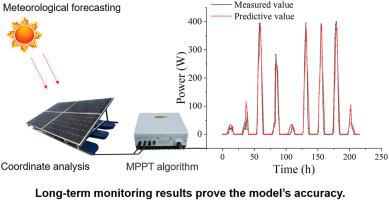Journal of Building Engineering ( IF 6.7 ) Pub Date : 2023-06-01 , DOI: 10.1016/j.jobe.2023.106997 Yuan Zhi , Tao Sun , Xudong Yang

|
Accurate photovoltaic power forecasting provides essential information for the flexible control of building energy systems. This paper proposes a physical model with environmental parameter prediction and an improved maximum power point tracking algorithm for hourly photovoltaic power forecasting. This study incorporates the forecast of meteorological parameters into the photovoltaic model so that the physical model proposed in this paper can achieve photovoltaic power prediction in the face of different weather conditions compared to previous photovoltaic physical models in the literature. A hierarchical clustering algorithm was used to obtain future hourly irradiance based on different weather conditions. The coordinate analysis method was used to calculate the hourly irradiance received on the surface of the photovoltaic panel. An equivalent circuit model was used to calculate the current-voltage characteristics of photovoltaic panels. Finally, the output voltage of the photovoltaic panel was adjusted by the improved maximum power point tracking algorithm to obtain the photovoltaic power. This algorithm can accelerate the calculation process and avoid long convergence times or oscillations near the optimal value. A photovoltaic project located in central China was selected as a case study to verify the accuracy of the prediction model. The long-term monitoring results show that the relative error of the predicted irradiance of the photovoltaic panel surface is 18.5%. The mean absolute error of the forecasted photovoltaic power was 15.9% in 120 consecutive days under various weather conditions, indicating that the model had high accuracy compared with traditional machine learning methods.
中文翻译:

屋顶光伏分时功率预测的气象预报物理模型
准确的光伏功率预测为建筑能源系统的灵活控制提供了必要的信息。本文提出了一种具有环境参数预测的物理模型和一种改进的最大功率点跟踪算法,用于每小时光伏功率预测。本研究将气象参数的预测纳入光伏模型,使得本文提出的物理模型相比以往文献中的光伏物理模型能够实现面对不同天气条件下的光伏功率预测。层次聚类算法用于根据不同的天气条件获取未来每小时的辐照度。采用坐标分析法计算光伏板表面每小时接收到的辐照度。等效电路模型用于计算光伏板的电流-电压特性。最后通过改进的最大功率点跟踪算法调整光伏板的输出电压,得到光伏功率。该算法可以加快计算过程,避免收敛时间过长或在最优值附近振荡。选取位于华中地区的某光伏项目作为案例研究,验证预测模型的准确性。长期监测结果表明,预测的光伏板表面辐照度的相对误差为18.5%。平均绝对误差在各种天气条件下,连续 120 天预测的光伏功率为 15.9%,表明该模型与传统的机器学习方法相比具有更高的准确性。











































 京公网安备 11010802027423号
京公网安备 11010802027423号